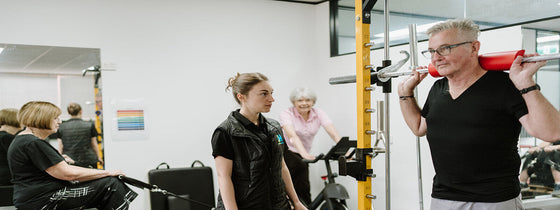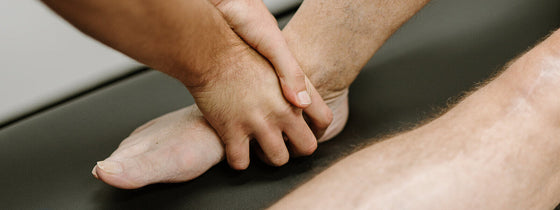Hamstring tears are common injuries in sports involving sprinting, jumping, kicking and changing of direction. In this blog, we cover how hamstring injuries can happen, the different ways the hamstrings can be injured, injury severity, and what you can do to prevent hamstring injuries.
How do you injure the hamstrings?
The hamstrings consist of three muscles that act on both the hip and knee joints. This means they work together to extend/straighten the hip and flex/bend the knee.
Muscles are often strained or torn when they are excessively stretched under load. This means that the hamstring is most likely to be injured when the hip is flexed/bent and the knee is straight, such as when your leg swings through whilst kicking a ball. The reason why this occurs is that as your leg swings through, the hamstrings contract to limit how much it swings through, whilst the muscle is also being lengthened or stretched at the same time. This is what we call an eccentric muscle contraction, and it is this type of contraction that places the greatest load on the hamstring. This explains why hamstring tears typically occur when sprinting or kicking.
What are the things that increase your risk of hamstring injury?
Some risk factors for hamstring injuries include:
The different types of hamstring injuries
Hamstring tears are not all the same. The location and severity of the injury will influence how to best manage the injury, and the duration of your recovery.
Location of hamstring injuries
There are a few different parts of the hamstring that can be injured. These are:
The key difference between these areas is their blood supply. The muscle belly has a bright red and fleshy appearance, due to its rich blood supply. Having a rich blood supply means it has greater potential for healing. Meanwhile, the musculotendinous junction and tendon have a whiter, fibrous appearance due to their lack of blood supply, meaning they have poor potential for healing. Therefore, a tear here will take longer to heal than a tear in the muscle belly and must be managed very carefully.
The severity of hamstring injuries
The severity of a hamstring tear is divided into three grades. The greater the severity, the longer the recovery time.
|
Grade |
Degree of damage |
|
1 (mild) |
A few muscle fibres may be overstretched or could have small tears |
|
2 (moderate) |
Partial tear of the muscle |
|
3 (severe) |
Complete tear of the muscle |
Other sources of hamstring pain
In some cases, hamstring pain may not be originating from the hamstring itself. In fact, it’s possible for pain in the hamstring to be stemming from the spine or the hip.
The sciatic nerve is a nerve that runs from the lower part of the spine, and down the back of the thigh and calf. At the points where the sciatic nerve exits the lumbar spine, it is possible for the nerve to become impinged, which can result in referred pain to the hamstring. The sciatic nerve can also be impinged by the muscles at the back of the hip, which can again produce referred pain to the hamstring. In these cases, the hamstring is often structurally intact, and the source of the pain may be neural. It is important to recognise this, as the treatment for neural pain may be different to that of a hamstring injury.
Diagnosis
With these variables in mind, we can better understand how important an accurate diagnosis is. If a severe hamstring tear, or involvement of the musculotendinous junction and/or tendon are suspected, an MRI may be valuable in guiding your management plan. Medical input, in addition to physiotherapy, may also be required.
Meanwhile, if a mild-moderate hamstring injury or neural-driven hamstring pain is suspected, a thorough physical assessment is often sufficient in guiding the management plan. A comprehensive strengthening and graded return to sport program may be all that is required.
Importance of hamstring length and strength
As discussed above, hamstring injuries often occur when the hamstring is stretched under load (i.e., eccentric contraction). Eccentric strength refers to how much force a muscle can produce whilst in a lengthened/stretched position, and it is these positions that place the greatest stress on a muscle. Therefore, it makes sense that performing eccentric strengthening exercises can boost the resilience of our hamstrings! Interestingly, research has shown that low levels of eccentric hamstring strength increase the risk of hamstring injuries. Meanwhile, higher levels of eccentric hamstring strength can mitigate the risk of injury, despite the presence of other risk factors such as older age. Furthermore, eccentric exercise can produce long-term improvements in muscle length and flexibility, whereas stretching may only provide short-term gains. Altogether, eccentric hamstring exercises are key to reducing your risk of hamstring injury! Some examples may include Nordic curls, Romanian deadlifts, and hamstring sliders.
If you’re looking to get your hamstrings in good shape, or you are recovering from a hamstring injury, come in and talk to one of our Physiotherapists for some guidance.

If you're experiencing back or neck pain with neurological signs and symptoms, a thorough neurological examination is crucial for accurate assessment and effective treatment. In this Optimal Tip learn more about what we mean by completing a neurological exam!

Squats, deadlifts, and calf raises are key movement patterns that should be part of every strength and conditioning program—regardless of age and activity level. These functional movements support joint health, improve posture and balance, and reduce the risk of injury while building strength where it matters most.

A ganglion cyst is a fluid-filled swelling that typically forms over a joint or tendon sheath, causing discomfort and pain, especially when pressing against nerves or joints. Proper assessment and treatment, including physiotherapy, are essential for managing symptoms and improving function in the presence of a ganglion in your hand, foot, or wrist.